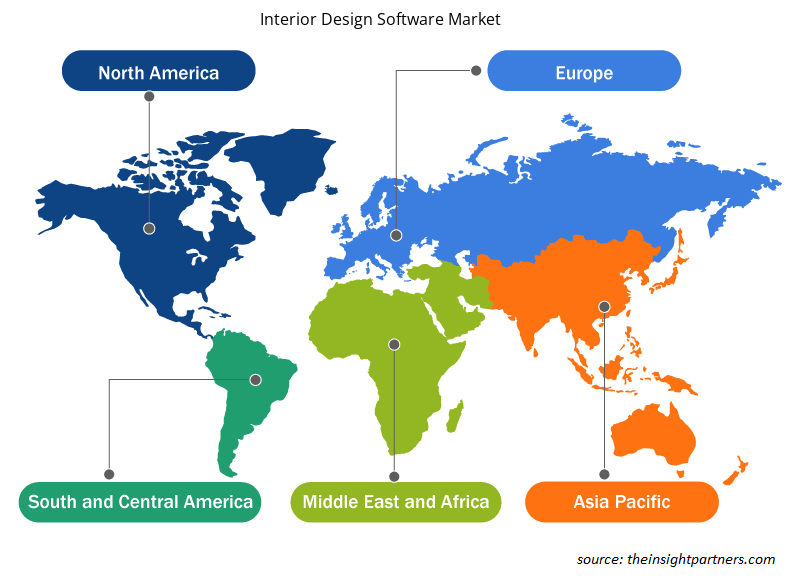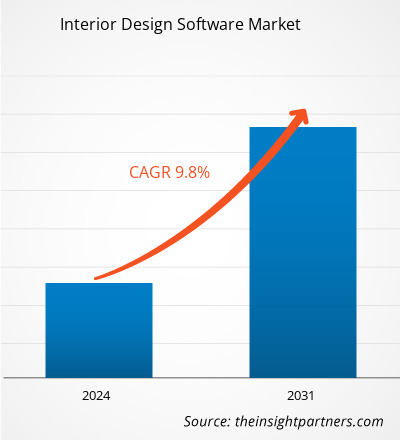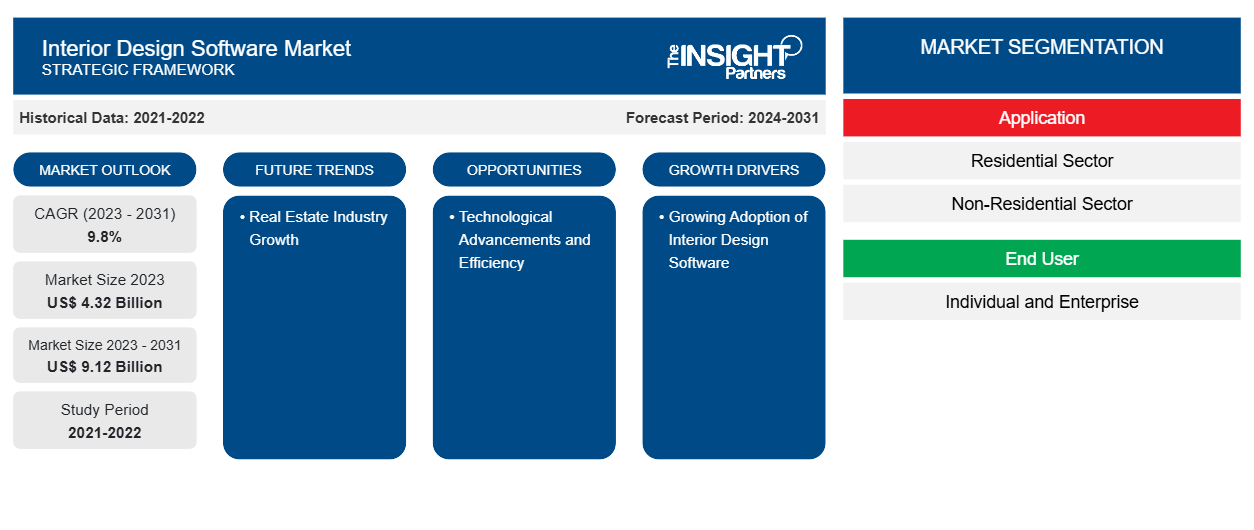인테리어 디자인 소프트웨어 시장 규모는 2023년 43억 2,000만 달러에서 2031년 91억 2,000만 달러로 성장할 것으로 예상됩니다. 이 시장은 2023~2031년 동안 9.8%의 CAGR을 기록할 것으로 예상됩니다. 부동산 산업 성장은 시장에서 핵심 트렌드로 남을 가능성이 높습니다.
인테리어 디자인 소프트웨어 시장 분석
생산성 향상에 대한 수요 증가는 이 시장을 주도하는 주요 요인 중 하나입니다. 또한, 더 나은 인테리어 디자인과 장식에 대한 수요 증가와 클라우드 기반 소프트웨어 사용 증가는 시장 성장을 촉진합니다. 인테리어 디자인 소프트웨어와 관련된 상호 운용성 문제는 이 시장의 성장을 제한합니다. 나아가, 가상화 프로세스의 성장과 중국과 같은 국가에서 빠르게 성장하고 있는 인테리어 디자인 소프트웨어에 대한 수요는 시장에 여러 기회를 제공할 것으로 예상됩니다.
인테리어 디자인 소프트웨어 시장 개요
인테리어 디자인 소프트웨어를 사용하면 건축가가 내부 환경의 품질을 조기에 추정할 수 있습니다. 건축가는 이 소프트웨어를 사용하여 설계된 건물이 필요한 기준에서 벗어난 부분을 식별, 추적 및 측정할 수도 있습니다. 이 소프트웨어를 사용하면 건축가가 예방 조치를 취하여 리노베이션 및 재건축의 필요성을 줄일 수 있습니다. 또한 창문 , 문, 침대 및 테이블 디자인과 같은 포괄적인 옵션 컬렉션이 있어 디자이너가 방의 정확한 모델을 만드는 데 사용할 수 있습니다.
귀하의 요구 사항에 맞게 이 보고서를 사용자 정의하세요
이 보고서의 일부 또는 국가 수준 분석, Excel 데이터 팩을 포함하여 모든 보고서에 대한 사용자 정의를 무료로 받을 수 있으며 신생 기업 및 대학을 위한 훌륭한 혜택과 할인 혜택을 이용할 수 있습니다.
-
이 보고서의 주요 시장 동향을 알아보세요.이 무료 샘플에는 시장 동향부터 추정 및 예측까지 다양한 데이터 분석이 포함됩니다.
인테리어 디자인 소프트웨어 시장 동인 및 기회
인테리어 디자인 소프트웨어 채택 증가
인테리어 디자인 소프트웨어 시장의 주요 성장 동인은 건축가, 엔지니어, 계약자가 이러한 소프트웨어를 점점 더 많이 사용하고 있다는 것입니다. 인테리어를 평가하는 초기 설계 단계에서 상당한 기여를 했습니다. 오류를 줄이고, 효과적인 시간 관리를 가능하게 하며, 제안된 설계와 실제 시공의 차이점을 보여 주며, 평면도, 가구, 실내 장식을 사실적인 3차원 환경으로 설정하여 전반적인 효율성과 작업의 정확성을 향상시킵니다.
기술의 발전과 효율성
운영 효율성을 개선하기 위해 인테리어 디자인 소프트웨어를 광범위하게 채택하면서 동시에 나타난 글로벌 건설 활동의 갑작스러운 증가는 인테리어 디자인 서비스 부문의 성장을 크게 가속화합니다. 이러한 추세는 이 소프트웨어가 설계 프로세스를 가속화하고, 시간과 비용을 절약하며, 디자이너가 정확하고 사실적인 객실 모델을 만들 수 있도록 광범위한 가구 선택 컬렉션을 제공하는 능력에 의해 더욱 강화됩니다. 따라서 인테리어 디자인 소프트웨어의 통합이 확대되면서 운영이 용이해질 뿐만 아니라 시장의 절대적인 성장에도 기여하고 있습니다.
인테리어 디자인 소프트웨어 시장 보고서 세분화 분석
인테리어 디자인 소프트웨어 시장 분석에 기여한 주요 세그먼트는 애플리케이션과 최종 사용자입니다.
- 응용 프로그램을 기준으로 시장은 주거 부문과 비주거 부문으로 나뉩니다. 주거 부문 세그먼트는 2023년에 상당한 시장 점유율을 차지했습니다.
- 최종 사용자를 기준으로 시장은 개인과 기업으로 세분화됩니다. 기업 부문은 2023년에 상당한 시장 점유율을 차지했습니다.
지역별 인테리어 디자인 소프트웨어 시장 점유율 분석
인테리어 디자인 소프트웨어 시장 보고서의 지리적 범위는 주로 북미, 아시아 태평양, 유럽, 중동 및 아프리카, 남미 및 중부 아메리카의 5개 지역으로 나뉩니다.
인테리어 디자인 소프트웨어 시장의 지역별 개요는 다양한 지역에서 상당한 성장 기회를 보여줍니다. 아시아 태평양 지역에서 인구와 도시화의 증가, 특히 도쿄, 베이징, 뭄바이와 같은 주요 도시에서는 주거 부문에 대한 관심이 증가했으며, 중국의 국가 개발 전략과 같은 이니셔티브는 상당한 도시화를 목표로 합니다. 또한 아시아 태평양 지역은 중국과 인도와 같은 국가에서 건물 인프라 계획이 증가하고 베이징, 도쿄, 뭄바이와 같은 주요 도시에서 도시화와 인구 확장이 증가함에 따라 예측 기간 동안 시장에서 가장 높은 CAGR을 기록할 것으로 예상됩니다.CAGR in the market during the forecast period, attributed to increasing
인테리어 디자인 소프트웨어 시장 지역 통찰력
Insight Partners의 분석가들은 예측 기간 동안 인테리어 디자인 소프트웨어 시장에 영향을 미치는 지역적 추세와 요인을 철저히 설명했습니다. 이 섹션에서는 북미, 유럽, 아시아 태평양, 중동 및 아프리카, 남미 및 중미의 인테리어 디자인 소프트웨어 시장 세그먼트와 지리에 대해서도 설명합니다.

- 인테리어 디자인 소프트웨어 시장을 위한 지역별 특정 데이터 얻기
인테리어 디자인 소프트웨어 시장 보고서 범위
| 보고서 속성 | 세부 |
|---|---|
| 2023년 시장 규모 | 43억 2천만 달러 |
| 2031년까지 시장 규모 | 91억 2천만 달러 |
| 글로벌 CAGR (2023-2031) | 9.8% |
| 역사적 데이터 | 2021-2022 |
| 예측 기간 | 2024-2031 |
| 다루는 세그먼트 |
응용 프로그램으로
|
| 포함된 지역 및 국가 |
북아메리카
|
| 시장 선도 기업 및 주요 회사 프로필 |
|
인테리어 디자인 소프트웨어 시장 참여자 밀도: 비즈니스 역학에 미치는 영향 이해
인테리어 디자인 소프트웨어 시장 시장은 소비자 선호도의 변화, 기술 발전, 제품의 이점에 대한 인식 증가와 같은 요인으로 인해 최종 사용자 수요가 증가함에 따라 빠르게 성장하고 있습니다. 수요가 증가함에 따라 기업은 제품을 확장하고, 소비자의 요구를 충족하기 위해 혁신하고, 새로운 트렌드를 활용하여 시장 성장을 더욱 촉진하고 있습니다.
시장 참여자 밀도는 특정 시장이나 산업 내에서 운영되는 회사나 기업의 분포를 말합니다. 주어진 시장 공간에 얼마나 많은 경쟁자(시장 참여자)가 존재하는지 그 규모나 전체 시장 가치에 비해 나타냅니다.
인테리어 디자인 소프트웨어 시장에서 운영되는 주요 회사는 다음과 같습니다.
- 오토데스크 주식회사
- 주식회사 수석 건축가
- 다쏘시스템
- ECDESIGN 스웨덴 AB
- 룸스케처 AS
- 룸토도 OU
면책 조항 : 위에 나열된 회사는 어떤 특별한 순서에 따라 순위가 매겨지지 않았습니다.

- 인테리어 디자인 소프트웨어 시장 주요 업체 개요를 알아보세요
인테리어 디자인 소프트웨어 시장 뉴스 및 최근 개발
인테리어 디자인 소프트웨어 시장은 1차 및 2차 조사 이후의 질적, 양적 데이터를 수집하여 평가하는데, 여기에는 중요한 기업 출판물, 협회 데이터, 데이터베이스가 포함됩니다. 인테리어 디자인 소프트웨어 시장의 몇 가지 개발 사항은 다음과 같습니다.
- IKEA US는 저렴한 가격으로 전문적인 일대일 인테리어 디자인을 제공하는 완전히 새로운 프로그램인 IKEA Interior Design Service를 출시한다고 발표했습니다. 소비자와 기업은 전문가와 연결하여 창의적인 솔루션으로 모든 공간을 디자인할 수 있는 기회를 갖게 됩니다.
(출처: Inter IKEA Systems BV, 회사 웹사이트, 2023년 4월)
- 가장 큰 IKEA 리테일러인 Ingka Group은 오늘 새로운 AI 기반 디지털 디자인 경험인 IKEA Kreativ를 출시합니다. 직관적인 새로운 경험은 고객에게 컴퓨터와 스마트폰에서 자신의 생활 공간을 디자인하고 시각화할 수 있는 최초의 실감 나는 완전 통합 방식을 제공합니다.
(출처: Inter IKEA Systems BV, 회사 웹사이트, 2022년 7월)
인테리어 디자인 소프트웨어 시장 보고서 범위 및 제공물
"인테리어 디자인 소프트웨어 시장 규모 및 예측(2021-2031)" 보고서는 아래 영역을 포괄하는 시장에 대한 자세한 분석을 제공합니다.
- 범위에 포함된 모든 주요 시장 세그먼트에 대한 글로벌, 지역 및 국가 수준의 인테리어 디자인 소프트웨어 시장 규모 및 예측
- 인테리어 디자인 소프트웨어 시장 동향과 드라이버, 제약 및 주요 기회와 같은 시장 역학
- 자세한 PEST/포터의 5가지 힘과 SWOT 분석
- 주요 시장 동향, 글로벌 및 지역 프레임워크, 주요 업체, 규정 및 최근 시장 동향을 포괄하는 인테리어 디자인 소프트웨어 시장 분석
- 시장 집중도, 히트맵 분석, 유명 업체 및 인테리어 디자인 소프트웨어 시장의 최근 동향을 다루는 산업 환경 및 경쟁 분석
- 자세한 회사 프로필
- 과거 분석(2년), 기준 연도, CAGR을 포함한 예측(7년)
- PEST 및 SWOT 분석
- 시장 규모 가치/거래량 - 글로벌, 지역, 국가
- 산업 및 경쟁 환경
- Excel 데이터세트
최근 보고서
관련 보고서
사용 후기
구매 이유
- 정보에 기반한 의사 결정
- 시장 역학 이해
- 경쟁 분석
- 고객 인사이트
- 시장 예측
- 위험 완화
- 전략 기획
- 투자 타당성 분석
- 신흥 시장 파악
- 마케팅 전략 강화
- 운영 효율성 향상
- 규제 동향에 발맞춰 대응























 무료 샘플 받기 - 인테리어 디자인 소프트웨어 시장
무료 샘플 받기 - 인테리어 디자인 소프트웨어 시장